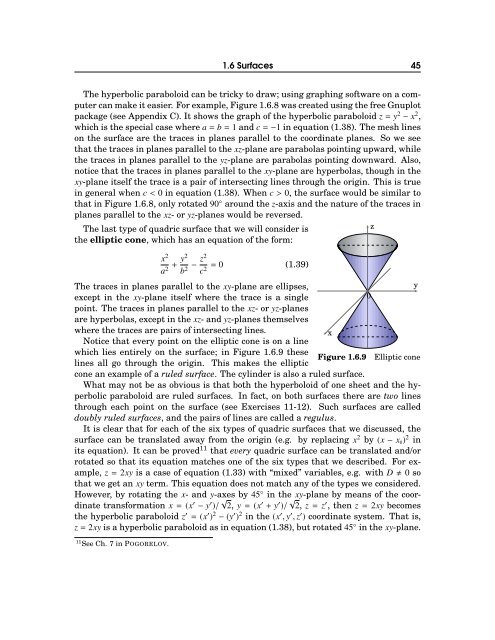Michael Corral: Vector Calculus
Michael Corral: Vector Calculus
Michael Corral: Vector Calculus
Create successful ePaper yourself
Turn your PDF publications into a flip-book with our unique Google optimized e-Paper software.
1.6 Surfaces 45<br />
The hyperbolic paraboloid can be tricky to draw; using graphing software on a computercanmakeiteasier.<br />
Forexample,Figure1.6.8wascreatedusingthefreeGnuplot<br />
package (see Appendix C). It shows the graph of the hyperbolic paraboloid z=y 2 − x 2 ,<br />
whichisthespecial casewherea=b=1andc=−1inequation(1.38). Themeshlines<br />
on the surface are the traces in planes parallel to the coordinate planes. So we see<br />
thatthetracesinplanesparalleltothe xz-planeareparabolaspointingupward,while<br />
the traces in planes parallel to the yz-plane are parabolas pointing downward. Also,<br />
notice that the traces in planes parallel to the xy-plane are hyperbolas, though in the<br />
xy-plane itself the trace is a pair of intersecting lines through the origin. This is true<br />
in general when c0, the surface would be similar to<br />
that in Figure 1.6.8, only rotated 90 ◦ around the z-axis and the nature of the traces in<br />
planes parallel to the xz- or yz-planes would be reversed.<br />
The last type of quadric surface that we will consider is<br />
the elliptic cone, which has an equation of the form:<br />
x 2<br />
a 2+y2 b 2−z2 c2= 0 (1.39)<br />
The traces in planes parallel to the xy-plane are ellipses,<br />
y<br />
except in the xy-plane itself where the trace is a single 0<br />
point. The traces in planes parallel to the xz- or yz-planes<br />
are hyperbolas, except in the xz- and yz-planes themselves<br />
where the traces are pairs of intersecting lines. x<br />
Notice that every point on the elliptic cone is on a line<br />
which lies entirely on the surface; in Figure 1.6.9 these<br />
Figure 1.6.9 Elliptic cone<br />
lines all go through the origin. This makes the elliptic<br />
cone an example of a ruled surface. The cylinder is also a ruled surface.<br />
What may not be as obvious is that both the hyperboloid of one sheet and the hyperbolic<br />
paraboloid are ruled surfaces. In fact, on both surfaces there are two lines<br />
through each point on the surface (see Exercises 11-12). Such surfaces are called<br />
doubly ruled surfaces, and the pairs of lines are called a regulus.<br />
It is clear that for each of the six types of quadric surfaces that we discussed, the<br />
surface can be translated away from the origin (e.g. by replacing x 2 by (x− x 0 ) 2 in<br />
its equation). It can be proved 11 that every quadric surface can be translated and/or<br />
rotated so that its equation matches one of the six types that we described. For example,<br />
z=2xy is a case of equation (1.33) with “mixed” variables, e.g. with D0so<br />
that we get an xy term. This equation does not match any of the types we considered.<br />
However, by rotating the x- and y-axes by 45 ◦ in the xy-plane by means of the coordinate<br />
transformation x=(x ′ − y ′ )/ √ 2, y=(x ′ + y ′ )/ √ 2, z=z ′ , then z=2xy becomes<br />
the hyperbolic paraboloid z ′ = (x ′ ) 2 − (y ′ ) 2 in the (x ′ ,y ′ ,z ′ ) coordinate system. That is,<br />
z=2xy is a hyperbolic paraboloid as in equation (1.38), but rotated 45 ◦ in the xy-plane.<br />
11 See Ch. 7 in POGORELOV.<br />
z








